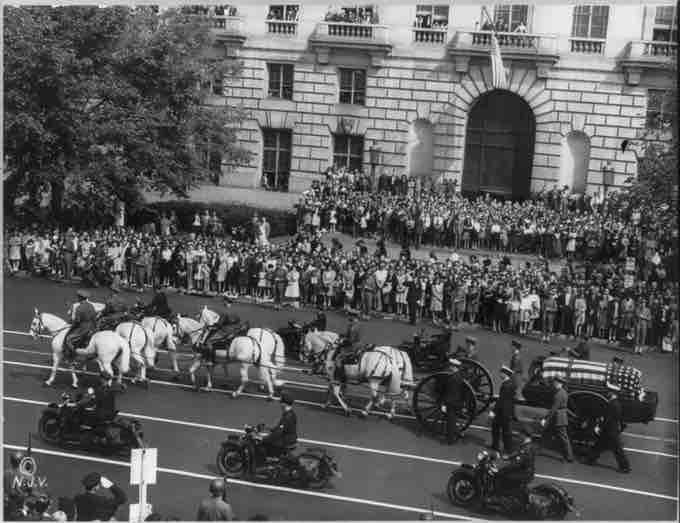THE ELECTION OF 1944
The United States presidential election of 1944 took place while the United States was preoccupied fighting World War II. President Franklin D. Roosevelt (FDR) had been in office longer than any other president, but remained popular. Unlike in 1940, there was little doubt that Roosevelt would run for another term as the Democratic candidate. His Republican opponent was New York Governor Thomas E. Dewey. Dewey ran an energetic campaign, but as expected, Roosevelt prevailed. Roosevelt replaced his Vice-President Henry Wallace with Missouri Senator Harry S. Truman, best known for his battle against corruption and inefficiency in wartime spending. Roosevelt and Truman won by a comfortable margin, defeating Dewey and his running mate John W. Bricker with 53.4% of the popular vote and 432 out of the 531 electoral votes. The President campaigned in favor of a strong United Nations, so his victory symbolized support for the nation's future participation in the international community.
THE FINAL TERM
The most important development of Roosevelt's final terms was representing the United States at the Yalta Conference, held February 4–11, 1945 in the Livadia Palace near Yalta in Crimea. It was one of the major wartime meetings of Allies Powers and was led by Roosevelt, UK Prime Minister Winston Churchill, and Soviet Union's General Secretary Joseph Stalin. The meeting was intended mainly to discuss the re-establishment of the nations of war-torn Europe. Each leader had his own agenda for the meeting. Roosevelt wanted Soviet support in the U.S. Pacific War against Japan, specifically invading Japan. Churchill pressed for free elections and democratic governments in Eastern and Central Europe (specifically Poland). Stalin demanded a Soviet sphere of political influence in Eastern and Central Europe, an essential aspect of the USSR's national security strategy.
The President left the Yalta Conference on February 12, 1945, flew to Egypt and boarded the USS Quincy operating on the Great Bitter Lake near the Suez Canal. Aboard the Quincy, the next day he met with Farouk I, king of Egypt, and Haile Selassie, emperor of Ethiopia. On February 14, he held a historic meeting with King Abdulaziz, the founder of Saudi Arabia, a meeting which established the subsequent special relationship between the two countries.
When Roosevelt returned to the United States, he addressed Congress on March 1 about the Yalta Conference, and many were shocked to see how old, thin and frail he looked. He spoke while seated in the well of the House, an unprecedented concession to his physical incapacity. In March 1945, he sent strongly worded messages to Stalin accusing him of breaking his Yalta commitments over Poland, Germany, prisoners of war and other issues. When Stalin accused the western Allies of plotting a separate peace with Hitler behind his back, Roosevelt replied: "I cannot avoid a feeling of bitter resentment towards your informers, whoever they are, for such vile misrepresentations of my actions or those of my trusted subordinates."
DECLINING HEALTH AND DEATH
On March 29, 1945, Roosevelt went to the Little White House at Warm Springs, Georgia, to rest before his anticipated appearance at the founding conference of the United Nations. On the afternoon of April 12, Roosevelt said, "I have a terrific pain in the back of my head. " He then slumped forward in his chair, unconscious, and was carried into his bedroom. The president's attending cardiologist, Dr. Howard Bruenn, diagnosed a massive cerebral hemorrhage (stroke). At 3:35 pm that day, Roosevelt died.
On the morning of April 13, Roosevelt's body was placed in a flag-draped coffin and loaded onto the presidential train. After a White House funeral on April 14, Roosevelt was transported back to Hyde Park by train, guarded by four servicemen, one each from the Army, Navy, Marines, and Coast Guard. As was his wish, Roosevelt was buried in the Rose Garden of the Springwood estate, the Roosevelt family home in Hyde Park, on April 15. Eleanor, who died in November 1962, was buried next to him.
Roosevelt's death was met with shock and grief across the United States and and around the world. His declining health had not been known to the general public. Less than a month after his death, on May 8, the war in Europe ended. President Harry S. Truman, who turned 61 that day, dedicated Victory in Europe Day and its celebrations to Roosevelt's memory, and kept the flags across the U.S. at half-staff for the remainder of the 30-day mourning period. In doing so, Truman said that his only wish was "that Franklin D. Roosevelt had lived to witness this day."

FDR's Funeral Procession
President Franklin Delano Roosevelt's funeral procession with horse-drawn casket down Pennsylvania Avenue, Washington, D.C., April 14, 1945.